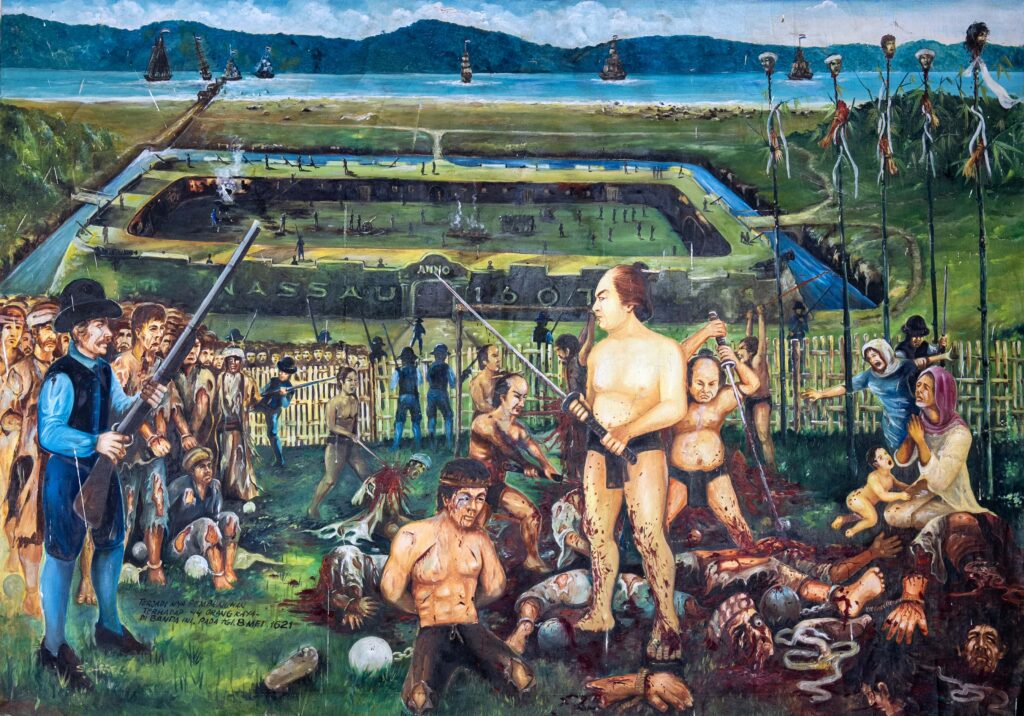After the Banda Massacre, the Tears of Myristica Fragrans – 8 May 1621
A presentation by Dr M Ahmedullah
8 May 2025, 7-9 pm
Click the link below to buy your ticket.

When the Dutch and the English successfully navigated their ships around the southern tip of Africa into the Indian Ocean waters around 1600 and returned with spices from the source in what is present-day Indonesia, competition between them to obtain the most sought-after spice quickly turned into open warfare.
In 1599, the Dutch first sailed into the Banda Islands, a small archipelago of eleven small pieces of land, the only place where the nutmeg tree grew. From early on, they sought to interfere in the islands’ affairs and worked to achieve a slow takeover. By late 1616, the Dutch had brought most of the archipelago under their control, some directly by force and others indirectly by pressuring the leaders of the island communities with threats to sign contracts.
However, the English, under the leadership of Captain Nathaniel Courthope, managed to get hold of the one island still outside the Dutch control, Pulau Rhun (Run Island), which they fortified, defended and held for four years. However, in October 1620, the Dutch overpowered them after Captain Nathaniel Courthope was finally tracked down and shot at night in the middle of the sea.
When taking over the only English stronghold in the Banda Islands in October 1620 and finally conquering the whole of the Banda archipelago by early 1621, the Dutch Governor-General, Jan Pieterszoon Coen, accused the leaders of the Banda Islands communities of planning a rebellion, charged them with treason and had them executed. In total, forty-four leaders, known as orang kayas, were sentenced to death and ordered Japanese mercenaries to carry out the sentence, which they did with relish: beheaded and quartered them.
After that, the Dutch had all the nutmeg forests in the Banda Islands but lacked skilled labour to care for the nutmeg trees, harvest the fruit and produce the mace and nutmeg spices. So, they brought slaves from many places, most of whom, in the early days, were from Bengal and the Coromandel coast of India, and got some Bandanese people they enslaved to teach the newcomers.
This session will tell the story of the humble nutmeg, explore the tragic event of 1621, and discuss how the islanders – made up of a new people from a mixture of many – are now dealing with the impacts of more than three centuries of Dutch rule over their archipelago and the genocide of 1621.
About Dr M Ahmedullah
Dr M Ahmedullah completed his PhD in 1998 at the University of Kent, where he studied, part time, ‘The Relationship between Epistemology and Political Theory’. Most of his career involved working for local governments in London on major inner city regeneration programmes between 1989 and 2010. Since 2010, he has been involved in the voluntary sector in East London, working for the Stepney Community Trust (SCT) and helping to found and run the Brick Lane Circle. In addition to serving on the management committee, he developed and managed many innovative initiatives and projects, focusing on East India Company, community cohesion and Bengal history.
Working with several hundred community participants since 2008, Dr M Ahmedullah managed around ten heritage and community cohesion projects that successfully engaged people from diverse backgrounds and helped them research and write books on historical and community cohesion topics, such as Plassey’s Legacy; Bengal to Bengal to Britain; Heirlooms from Asia; From Red Dragon to Nemesis; Struggles of Bangladeshi Squatters of Myrdle Street and Parfett Street (1975-1995); Knowing one another; Knowing One Another through the Art of Drama; Untold Stories of the East India Company; I sewed, I sewed and I sewed; East India Company Spice Wars Stories.